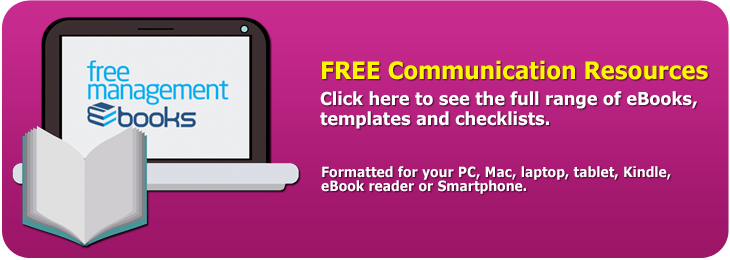Delivering a Presentation - Free eBook in PDF Format
 |
 |
|
Book Description - ISBN 978-1-62620-966-4 (46 Pages)
This free eBook explains how to deliver your presentation in a way that will keep the audience engaged from the beginning to the final conclusion. It follows on from 'Planning a Presentation' and 'Preparing a Presentation,' which explain how to organize your material in a way that works as a presentation to an audience.
Chapter 1 - Giving a Management Presentation
There are three key elements of delivering a presentation: Your style of delivery, understanding your audience and ensuring the venue supports your message.
Chapter 2 - Cue Card Guidelines
There are three presentation styles that you can use: memorizing the content, reading from a full script, or using free, conversational speech aided by cue cards.
Chapter 3 - Styles of Presenting
Cue cards should be sequentially numbered, only one side should be used, and each card should deal with only one key point. Presenting in this style allows the audience to view you as someone who owns this information and is knowledgeable about it.
Chapter 4 - Developing a Persuasive Delivery Style
A persuasive delivery style involves mastery of voice, body language, and eye contact. You should make a conscious effort to eradicate any verbal mannerisms you may have. These include: droning, aural punctuation, hesitation, or verification.
Chapter 5 - How to Rehearse
The only way to develop your delivery skills is through continual practice, criticism, and revision. Remember, audiences like knowledgeable, confident, and enthusiastic presenters. Use the video camera on your cell phone to record your rehearsals. This will help you overcome any annoying mannerisms you may have.
Chapter 6 - Reading Your Audience
Reading the audience's body language can help you to modify the pace of your delivery to keep as many people on board as possible. It can also help you to gauge who is in agreement with you, who is opposing your point of view, and who has yet to decide.
Chapter 7 - Retaining Control in a Presentation
You need to have a strategy for dealing with unexpected questions. The safest approach is to acknowledge the question saying that there is insufficient time to answer it properly and to promise to deal with it during the Q&A session or after the presentation. Never allow yourself to be drawn into an argument, but don't appear arrogant or unconcerned about issues that other people feel strongly enough about to bring up.
Chapter 8 - Question and Answer Session
You should plan for the Q&A session rather than leaving it to chance because a lack of questions after a presentation can make it look as though no one was really interested in the message.
Chapter 9 - Importance of the Presentation Venue
Make sure that you have access to the room before your presentation so that you can check it meets your requirements and that any technology you need works as it should.
Chapter 10 - Presentation Venue Layout
The layout of the venue can have a big impact on the effectiveness of your presentation. Take control of the venue as early as possible, remove any distractions, and encourage people to occupy seats starting at the front of the room rather than the back. Always have a back-up plan in case the technology fails and you can't use your visual aids or your time slot is shortened.
| You will learn how to: |
|
![]()
![]()
The strategies offered in the book are a welcome addition to my arsenal
I am generally a confident person in my day to day life - but that confidence does not carry over into the area of delivering a presentation. When I came across this eBook, it was a no-brainer that I was going to take the time to read it through. Just the possibility that this book could help me become a more confident and polished presenter was more than enough to make me want to give it a try. I am happy to say that I gained ideas and tips from this book that I expect to help me in my next presentation. I'm not sure that giving a presentation will ever be my favorite thing to do, but I'm hoping that I will be at least a little closer to being more comfortable with it.
In a funny way, this book made me feel better about my own presentations by confirming something I already do. In the past, I have felt self-conscious about the fact that I repeat myself over and over during a presentation. I always feel like the audience is getting tired of hearing me say the same thing, and maybe they are, but this book confirms that I have been doing the right thing. The next time I need to give a presentation, I will remember what I read in this book and won't worry so much about being repetitive.
Another point offered up in the book that made more confident is that it is not necessary to memorize all of your presentations. I have always felt better working off of note cards , but worried that it made me appear unprepared for the task. This books seems to stand behind the cue card method as the most reliable for the average presentation, so again I felt justified that my habits were maybe not as bad as I once feared.
The book goes on to highlight the methods one can use for preparing and using cue cards during a presentation. This section has a lot of solid advice, but didn't do much for me because I already have experience giving cue card-based presentations. For someone who hasn't used cue cards, however, this section could come in very handy.
This book includes a section on body language which I found to be particularly useful and interesting. Much of my discomfort with giving a presentation comes from feeling awkward standing in front of the room - not so much about what I am actually saying. The body language section gave me some good ideas for ways to feel more comfortable while standing in front of the group. I'm sure it will not be that simple to implement when I am actually giving a presentation, but at least now I have a strategy in mind.
Later on in the book comes a short section which, for me, I think will be the most beneficial. It talks about how to deal with unexpected disruptions during a presentation - such as when someone questions something you have said, or raises and issue you are not prepared to deal with. This is probably the biggest fear for me during a presentation, so the strategies offered in the book are a welcome addition to my arsenal. Hopefully, I will be able to calmly put them into action if this situation should arise in the future.
I still don't look forward to giving my next presentation, but I do think that the quality of that presentation will be improved thanks to what I have learned from this eBook. If you are in any kind of role that requires you to give presentations from time to time, make sure to read this book next time you have the chance.
Gerald Cohen
Contains good advice on how best to rehearse
If you are anything like me, the thought of giving a presentation to a large crowd will cause more than a few sleepless nights. As much as I dislike presenting to crowds, I do take some comfort in being well-prepared and as such, this book caught my interest. I have read some of the other books for the same people and found each of them to be pretty interesting while remaining to the point.
Right of the bat this guide covers the four main styles of presenting which are memorizing, reading a script, using cue cards, or using cue card guidelines. While memorizing and reading a script as pretty self-explanatory, the cue cards can be used in a couple of ways. The first being as a summarized script and the second is merely as an outline to ensure you cover key points. Either way, saying what you have prepared is only part of the battle.
The main points of effective speaking outlined are proper use of voice, body language, and eye contact. As you can imagine, presenting your ideas in an authoritative and confident manner will be more convincing than if you simply mumble through the script. Likewise, reciting the speech from memory of cue cards will make you seem more knowledgeable and credible on a subject. Just as making proper gestures and cues can make you seem credible, mistakes can erode the confidence of your audience. Interestingly, this book covers aural punctuation as one of the primary destroyers of effective speaking. Hesitation is also listed as a killer of good speaking. Additionally droning and over verification tends to turn listeners off to an otherwise well planned and effective speech.
I felt that the section of this book that covers the best way to ensure an audience is following along without over verifying it to engage them into the conversation or of course inspect the body language. Likewise, just as the audience body language will help you gauge their enthusiasm, your body language will influence their opinion of you as well, sometimes more than your words. Eye contact is another topic well covered in this book and it is again not something that should be overlooked. While many of us know what we need to do to give a speech, less of us know just how to ensure we do it right. One of the most informative parts of this book I found was the section on rehearsing and the various methods one could use.
Some of the suggestions include videotaping yourself, rehearsing in front of a group, and rehearsing alone. Each of these methods is good but group and video allows for constructive feedback of your speech from peers. Regardless of how you choose to rehearse, you must make time for unbiased feedback if you really want to improve your speaking skills. If you really want to nail your next speech, this book is worth a read.
Kirsten Moore


